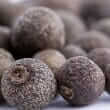Background
- Allspice is produced from the fruit of the Pimenta dioica plant and originates primarily from Jamaica, the West Indies in general, and South America. The fruits are picked when they are green, then dried in the sun or in a kiln and sold as either whole dried fruit or in powdered form. Allspice has a complex, peppery taste similar to a mix of cinnamon, juniper, clove, and nutmeg.
- Historically, allspice was used to treat indigestion and intestinal gas. It was also taken by mouth to treat stomachaches, heavy menstrual bleeding, vomiting, diarrhea, fever, flu, and colds. Commercially, allspice has been used to flavor toothpastes.
- Currently, there is limited high-quality evidence supporting any clinical use of allspice.
References
Natural Standard developed the above evidence-based information based on a thorough systematic review of the available scientific articles. For comprehensive information about alternative and complementary therapies on the professional level, go to . Selected references are listed below.
- Blomhoff R. [Antioxidants and oxidative stress]. Tidsskr Nor Laegeforen. 2004;124(12):1643-1645.
View Abstract - Doyle, B. J., Frasor, J., Bellows, L. E., Locklear, T. D., Perez, A., Gomez-Laurito, J., and Mahady, G. B. Estrogenic effects of herbal medicines from Costa Rica used for the management of menopausal symptoms. Menopause. 2009;16(4):748-755.
View Abstract - Du, W. X., Olsen, C. W., Avena-Bustillos, R. J., McHugh, T. H., Levin, C. E., and Friedman, M. Effects of allspice, cinnamon, and clove bud essential oils in edible apple films on physical properties and antimicrobial activities. J Food Sci 2009;74(7):M372-M378.
View Abstract - Dragland S, Senoo H, Wake K, et al. Several culinary and medicinal herbs are important sources of dietary antioxidants. J Nutr 2003;133(5):1286-1290.
View Abstract - Kanerva L, Estlander T, Jolanki R. Occupational allergic contact dermatitis from spices. Contact Dermatitis 1996;35(3):157-162.
View Abstract - Kikuzaki H, Miyajima Y, Nakatani N. Phenolic glycosides from berries of Pimenta dioica. J Nat Prod. 3-4-2008;
View Abstract - Kluth D, Banning A, Paur I, et al. Modulation of pregnane X receptor- and electrophile responsive element-mediated gene expression by dietary polyphenolic compounds. Free Radic Biol Med. 2-1-2007;42(3):315-325.
View Abstract - Kobayashi S, Watanabe J, Fukushi E, et al. Polyphenols from some foodstuffs as inhibitors of ovalbumin permeation through caco-2 cell monolayers. Biosci Biotechnol Biochem 2003;67(6):1250-1257.
View Abstract - Lee YH, Hong SW, Jun W, et al. Anti-histone acetyltransferase activity from allspice extracts inhibits androgen receptor-dependent prostate cancer cell growth. Biosci Biotechnol Biochem 2007;71(11):2712-2719.
View Abstract - Marzouk MS, Moharram FA, Mohamed MA et al. Anticancer and antioxidant tannins from Pimenta dioica leaves. Z Naturforsch.[C.] 2007;62(7-8):526-536.
View Abstract - Niinimaki A. Double-blind placebo-controlled peroral challenges in patients with delayed-type allergy to balsam of Peru. Contact Dermatitis 1995;33(2):78-83.
View Abstract - Niinimaki A. Delayed-type allergy to spices. Contact Dermatitis 1984;11(1):34-40.
View Abstract - Takemasa, N., Ohnishi, S., Tsuji, M., Shikata, T., and Yokoigawa, K. Screening and analysis of spices with ability to suppress verocytotoxin production by Escherichia coli O157. J Food Sci 2009;74(8):M461-M466.
View Abstract







